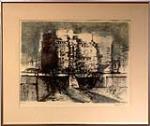The City
- School of Art and Design Permanent Collection
- Brush like sketch of buildings and gestural figures; signed; silver frame; creme mat board. The City is a take on how life in Rome was after WWII. The building seen is looking dilapidated or destroyed while dark colors encircle it. There are two figures in the bottom right, one seemingly bent over as they try to pull something while the other observes.
- Importance of work: The work is likely part of Renzo’s Citta Aperta review. A magazine that was concerned with the lower class’s cultural problems after the war. This work, and the magazine as a whole, display a connection with Italian neorealism. This movement is sometimes known as “the Golden Age” and included films shot in poor neighborhoods to show the complex struggles working class Italians faced after WWII.
-
Renzo Vespignani
Italian February 19, 1924 - 26 April 2001
Read Biography
Renzo Vespignani
Vespignani illustrated the works of Boccaccio, Kafka and T. S. Eliot, among others.[2] In 1956, he co-founded the magazine Citta Aperta ("City Opened") and in 1963, co-founded the group II Pro e II Contro (Pro and Con) for neorealism in figure art Renzo was born in Rome, Italy in 1924. At the age of 14, he began to paint during the most difficult years of Germany’s occupation of Italy. In 1944 he recorded the ravages of Rome in realistic detail. 11 years after the war Renzo co-founded Citta Aperta, which drew attention to Rome’s harshest neighborhoods. Next, he founded the group Pro and Con with a plethora of other Italian artists to develop new intellectual figural art. By 1970 he very rarely went abroad and lived the remainder of his life in Italy until 2001.
- No
- Intaglio
